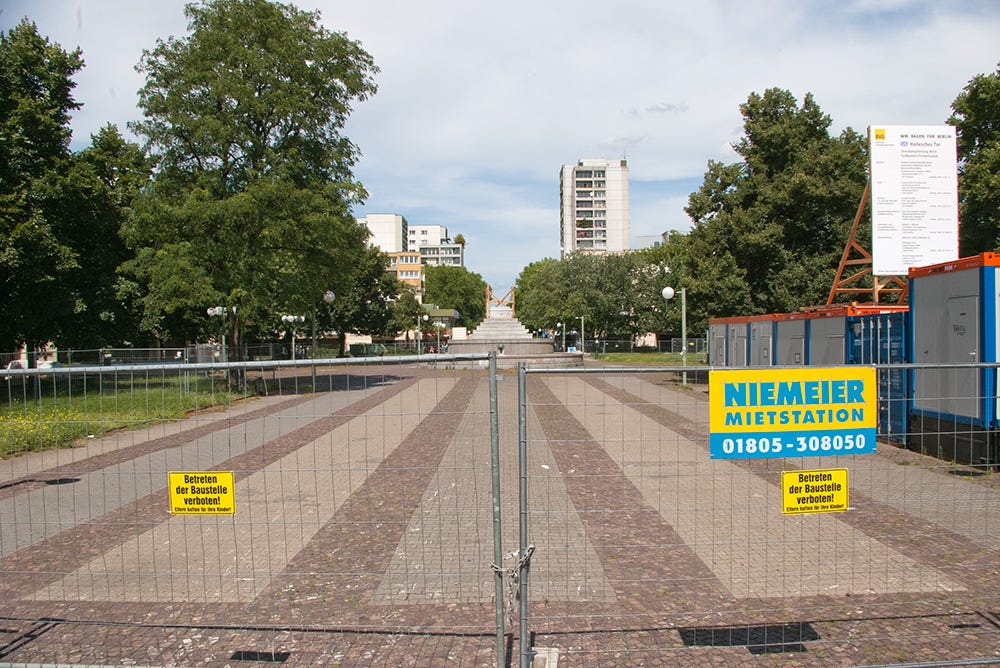February 2005
I first encountered Mehringplatz, which is situated at the southernmost end of Friedrichstraße in Berlin, on a bright and frosty morning in February 2005. This was while on my first trip to Berlin, as part of my Masters degree art history course.
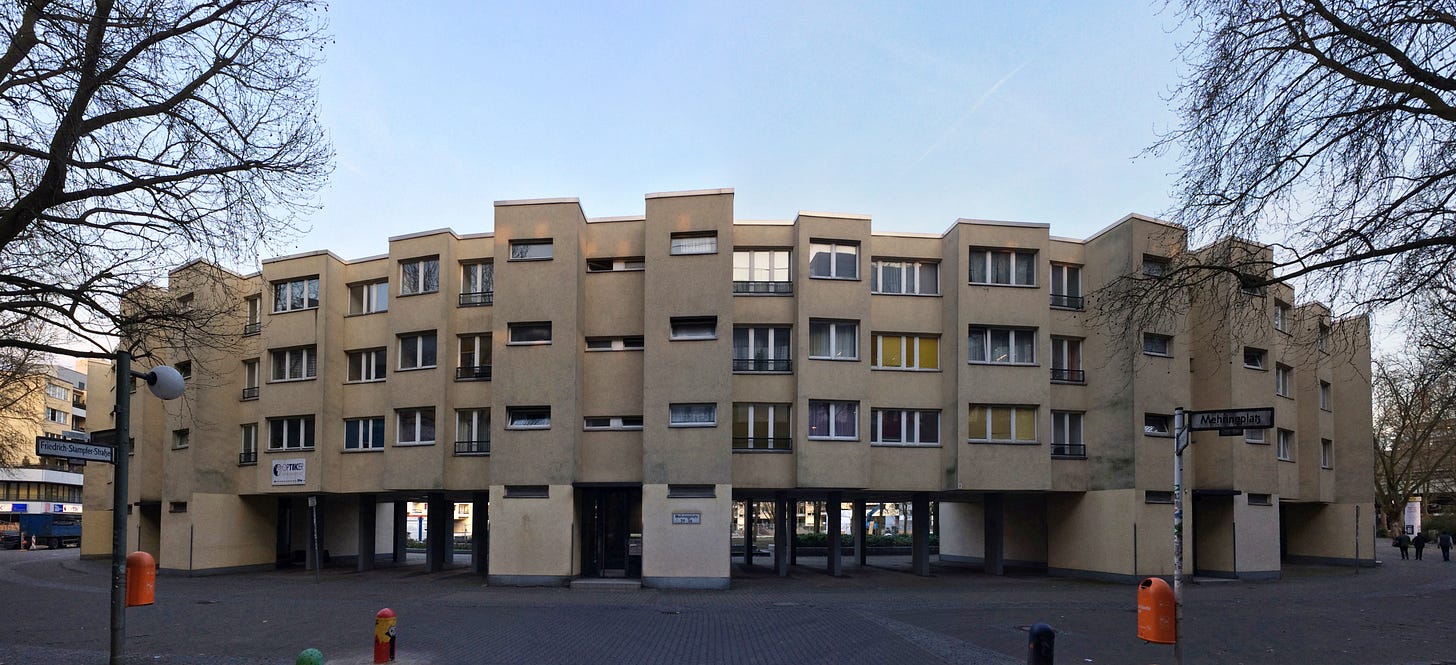
It was bitterly cold and we were in a rush to get from the Hallesches Tor U-Bahn station to the Berlinische Galerie, a five-minute walk away. I had my coat collar clutched against my throat and my eyes focused on the frosty pavement in front of me, so I paid scant attention to my surroundings. My lasting impression of what I did see was how familiar the place seemed, for it bore more than a passing resemblance to the town square in Basildon, the post-war Essex town close to where I grew up, which had been built from nothing in the 1960s. Like Mehringplatz it had a central open space with a fountain at its centre, housing blocks and shops around the perimeter, and was characterised by concrete hues and brutalist aesthetics.
After crossing the open space we walked for a bit around its perimeter, under housing blocks raised on stilts. The path was curved, following the circular shape of the … square? Perhaps, under the circumstances, I should use the German term Platz.
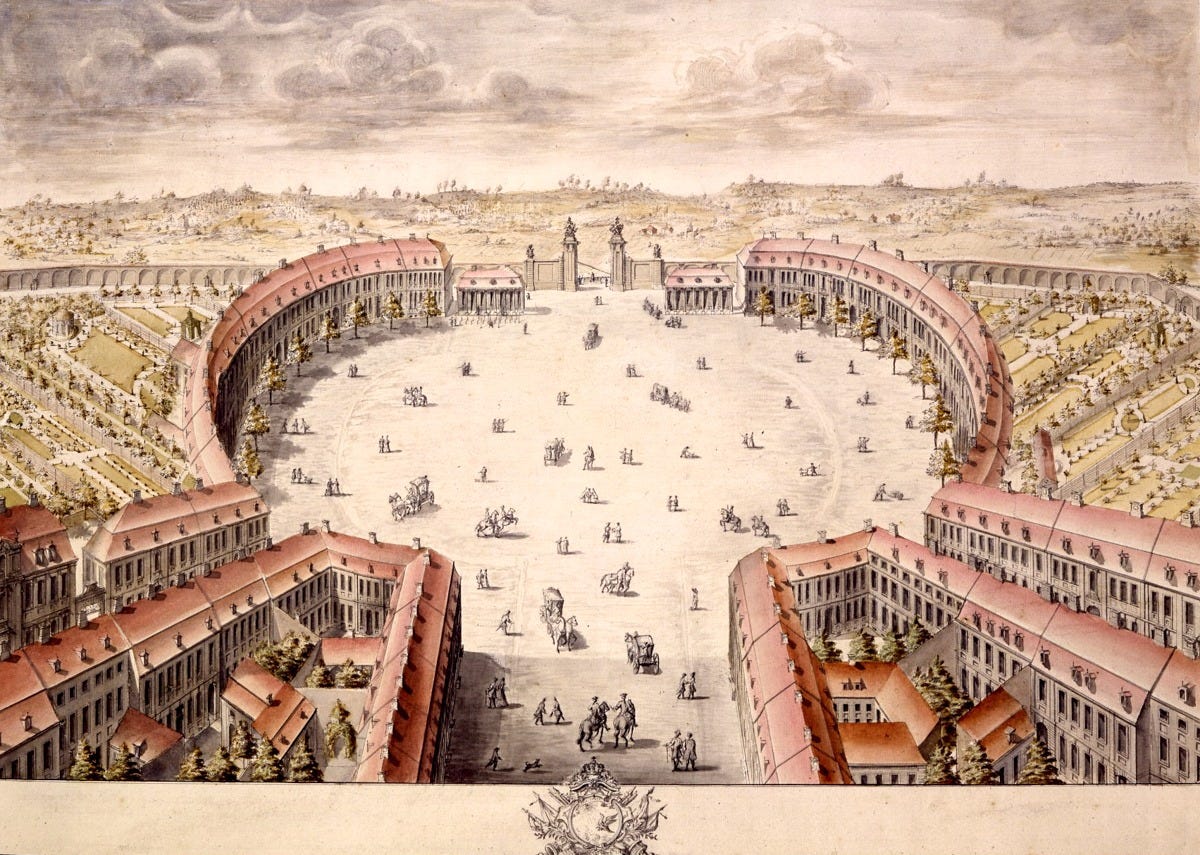
Berlin’s city planners marked out the dimensions of this Platz in the 1730s. They made it a circle, and simply called it the Rondell, or round. The Prussian king Friedrich Wilhelm I commissioned the Rondell, as one of three new market squares to be built behind three of the city’s gates. At the Hallesches Tor, the architects laid out the circular space of the Rondell. Of the two other squares, one was set out behind the Potsdamer Tor in the shape of an octagon, better known to us now as Leipziger Platz, while the other was designed as a rectangle behind the Brandenburger Tor, now Pariser Platz. Friedrich Wilhelm also ordered a customs wall be built around Berlin, ensuring that access into and out of the city was only possible at the official gates, including the Hallesches Tor, here, just to the south of the Rondell. Traders passing through the Hallesches Tor could sell their wares in the market that took place on the Rondell.
At other times the Rondell, like Berlin’s other Plätze, functioned as a military parade ground. Berlin was an important strategic settlement in Prussia, and headquarters of the Hohenzollern dynasty. With a large number of barracks scattered across the city, at the time of Friedrich Wilhelm’s reign it has been calculated that one in every ten inhabitants of Berlin was a soldier of some rank and type. A number of barracks lay just beyond the Hallesches Tor, as did the extensive drill grounds at Tempelhofer Feld. There was also one extensive set of barracks just behind the Rondell, within the city walls, where a cavalry regiment of the cuirassiers were based. These and other regiments within the city regularly made their way through the Rondell, on their way back and forth from the training grounds at the Tempelhofer Feld, so that those ‘noisy Janissary troops’ dominated the street life of the area.
July 2006
Eighteen months later and I found myself back on Mehringplatz/the Rondell. The contrast with that first visit couldn’t have been more pronounced, because this next visit took place in the sultry heat of a late afternoon in July 2006. This time around I was in less of a hurry, and took in my surroundings properly. Unlike last time I was here, the square bristled with people, energy and activity. This neighbourhood around Hallesches Tor is a predominantly Turkish one, and crowds of Turkish-German families and friends were gathered around clusters of plastic chairs outside of the cafés. They were laughing, chatting, and drinking from bottles and cans of Coca Cola. In the middle of the Platz children splashed in the water of a large fountain.
200 years earlier, on 27 November 1806, Napoleon and his troops entered Berlin through the Hallesches Tor, and occupied the Rondell. One can imagine, given the proud military nature of Prussian Berlin, what a humiliation this must have been, in the wake of the Prussian army’s capitulation at Jena and Auerstadt.
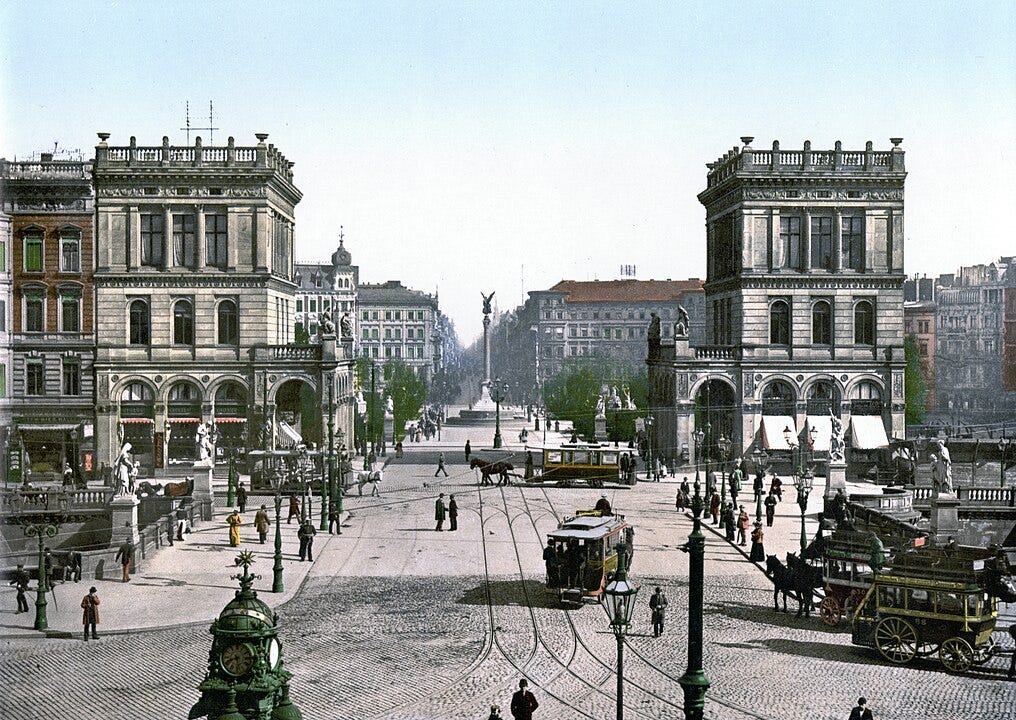
When Napoleon’s forces finally withdrew from Berlin in 1815, back across the Rondell and through the gate that they had come through nine years earlier, the Prussians had much to cheer. In commemoration of the alliance between Britain and Prussia that had inflicted defeat on Napoleon at Waterloo, the Rondell was renamed Belle-Alliance Platz. In 1843 a commemorative column, designed by Johann Gottlieb Christian Cantian, was built at the very heart of the square. The base of the column was hewn from silesian marble and contained a shallow pool, into which bronze lion’s heads spewed water. Rising out of the pool to a height of some nineteen metres was the granite column itself, at whose summit was perched an effigy, cast in bronze, of the Roman goddess Victoria, created by the sculptor Christian Daniel Rauch.
It was in this fountain that children now splashed about in, and I thought about how incongruous this scene looked, this symbol of a nineteenth-century military victory, amidst a modern twentieth-century cityscape, with crowds of children playing innocently beneath it.
July 2011
I returned to Mehringplatz in 2011. Though it was July once more, the weather was much cooler and cloudier than it had been six years earlier. To my surprise, I found the square nearly deserted, for it had been transformed into a building site, cordoned off as part of redevelopment plans for the U6 underground line that ran beneath it. Where local residents had previously gathered and milled about in a bustling public space, metal barriers now prohibited access.
I walked a circuit around the square, following the perimeter of the metal fencing. What a shame that the area’s residents could not enjoy the space this summer! What were once reasonably tidy grass areas, on which children scampered about and adults played boules, was now overgrown with foot-high weeds. The kids were still here, but this summer they had to amuse themselves amongst the concrete pillars and paving slabs of the housing estate surrounding the Platz. I could hear them now, their high-pitched voices bouncing off solid walls. “Scheisse!” one exclaimed. Beyond them I could hear another, more mature voice singing softly in Arabic, the rise and fall of its pitches reminiscent of the Friday calls from the mosque. The adult folks were still here as well, but they were altogether more subdued. One group sat idly outside a café, amidst plastic patio chairs and tables. A lady walked by, coaxing along a small dog on a lead.
Much of Berlin was devastated in the Second World War, and Belle-Allianz-Platz and its surrounding streets were no exception. In 1947 the largely destroyed space was renamed Mehringplatz, after the historian and socialist politician Franz Mehring. In the 1960s a new public housing estate designed by the architect Werner Düttmann was built around the circular space. At the same time, architects in Britain were creating Basildon New Town.
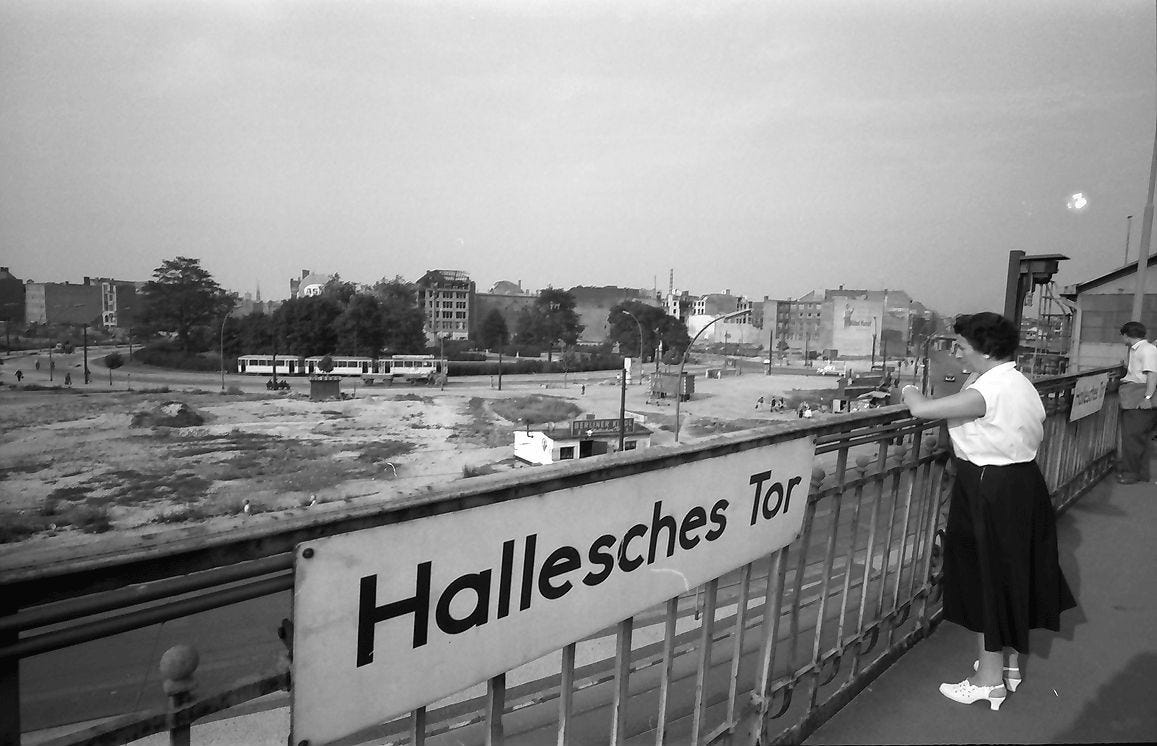
I sat down upon one of the concrete slabs bordering the raised flower beds that ran around the square. The bed behind me consisted of just bare earth and the occasional clump of grass. The shade from the trees was welcome, as was the cool breeze. Birdsong mingled with the Arabic song and children’s voices. Above and behind me were the balconies of the three-storey blocks of flats, on which not a single inch of space was left unadorned. The flower pots, window boxes and hanging boxes contained a riot of colour: bougainvillaea, fuchsias, potted herbs. Brightly-coloured ceramic plates hung on the partition walls. One balcony was entirely taken up with a metre-wide satellite dish. There were also pendants and chimes that let slip the occasional clang and tingle in the gentle breeze.
Just as I was wondering what had become of the fountain and victory column, I noticed that the column was still there in the square, amidst the groundworks, albeit on its side in bits and pieces, and covered with plastic blue tarpaulin. And now I noticed a sign affixed to the fencing, informing me that Rauch’s Victoria was safely stowed in a workshop for restoration.
I was surprised by how Mehringplatz had changed since my last visit, but I really shouldn’t have been. Now that I am only an occasional visitor to the city (lamentably, it’s been six years since my last stay in the summer of 2019) I’m very familiar with the the city being in a continual state of change: “immerfort zu werden und niemals zu sein”! Will the constant state of flux that Berlin seems to be in ever stop?




